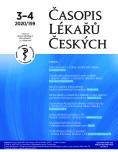-
Medical journals
- Career
Current possibilities of wound dressing with regard to pathophysiology of healing
Authors: Petr Šíma
Authors‘ workplace: Chirurgické oddělení, Fakultní nemocnice Plzeň
Published in: Čas. Lék. čes. 2020; 159: 153-156
Category: Review Article
Overview
Optimization of chronic wound treatment has been constantly a subject of research. Understanding the physiological healing of wounds, permanent development of new dressing materials and correct observance of antiseptic guidelines have led to new approaches in the care of chronic wounds.
The primary objective in treatment and care of chronic wounds is rapid wound closure with a functional and aesthetically acceptable scar. Though primary healing wounds is simple, many problems occur in chronic wounds, especially in the elderly and in patients with associated comorbidities. The wound should be maintained in conditions ensuring physiological healing. The condition of each wound must be properly evaluated; the wound must be carefully cleaned and then treated individually according to the current stage of healing.
Many of the formerly used therapeutic procedures are outdated today. At present we have numerous modern materials including bioactive dressings which should be used in treatment of chronic wounds. New findings in molecular and cellular biology have improved our knowledge of the physiological healing of wounds and the approach to wound treatment.
Keywords:
Wound healing – diabetic foot syndrome – chronic wound – defects of soft tissues – wound dressing
Sources
- Afradi H, Saghaei Y, Kachoei ZA et al. Treatment of 100 chronic thalassemic leg wound by plasma-rich platelets. Int J Dermatol 2016; 56 : 121–244.
- Bishop SM, Walker M, Rogers AA, Chen WY. Importance of moisture balance at the wound-dressing interface. J Wound Care 2003; 12 : 125–128.
- Bonn D. Maggot therapy: an alternative of wound infection. Lancet 2000; 356 : 1174.
- Bureš I. Lokální terapie moderními obvazovými prostředky u diabetické nohy. Bulletin HPB 2003; 11 : 35–36.
- Kujath P, Michelsen A. Wounds – from physiology to wound dressing. Dtsch Arztebl Int 2008; 105 : 239–248.
- Edwards R, Harding KH. Bacteria and wound healing. Curr Opin Infect Dis 2004; 17 : 91–96.
- Gürgen M. The TIME wound management system used on 100 patients at a wound clinic. In: Dealey C (ed.). Proceedings of the 17th Conference of the European Wound Management Association, 2007 May 2–4, Glasgow. European Wound Healing Association, 2007.
- Lippert H. Wundatlas. Kompendium der komplexen Wundbehandlung. Thieme Verlag, Stuttgart, New York, 2006.
- Martinez-Zapata MJ, Martí-Carvajal AJ, Solà I. Autologous platelet-rich plasma for treating chronic wounds. Cochrane Database Syst Rev 2016; 5: CD006899.
- Mohammadi MH, Molavi B, Mohammadi S et al. Evaluation of wound healing in diabetic foot ulcer using platelet-rich plasma gel: a single-arm clinical trial. Transfus Apher Sci 2017; 56 : 160–164.
- Perez-Zabala E, Basterretxea A, Larrazabal A et al. Biological approach feo the management of non-healing diabetic foot ulcers. J Tissue Viability 2016; 25 : 157–163.
- Shalaby SY, Blume P, Sumpio BE. New modalities in the chronic ischemic diabetic foot management. Clin Podiatr Med Surg 2014; 31 : 27–42.
- Sriram S, Sankaralingam R, Mani M, Tamilselvam TN. Autologous platelet rich plasma in the management of non-healing vasculitic ulcers. Int J Rheum Dis 2016; 19 : 1331–1336.
- NCD Risk Factor Collaboration (NCD-RisC). Worldwide trends in diabetes since 1980: a pooled analysis of 751 population-based studies with 4.4 million participants. Lancet 2016; 387 : 1513–1530.
- Yazdanpanah L, Nasiri M, Adarvishi S. Literature review on the management of diabetic foot ulcer. World J Diabetes 2015; 6 : 37–53.
Labels
Addictology Allergology and clinical immunology Angiology Audiology Clinical biochemistry Dermatology & STDs Paediatric gastroenterology Paediatric surgery Paediatric cardiology Paediatric neurology Paediatric ENT Paediatric psychiatry Paediatric rheumatology Diabetology Pharmacy Vascular surgery Pain management Dental Hygienist
Article was published inJournal of Czech Physicians

-
All articles in this issue
- Adult obese patient in primary care
- Obesity in childhood and adolescence and what we can do with an obese child in a pediatric health care
- Psychologické aspekty obezity
- Medical nutrition therapy of obesity and its metabolic complications
- Role of dietitian in obese patients’ care
- Obesity treatment in patients both with and without diabetes: current options and perspectives
- Overview of developments in bariatric surgery in the Czech Republic and worldwide and new trends in bariatric-metabolic surgery
- Laparoscopic gastric plication in the treatment of obesity and metabolic disorders: 10-years results
- Tobacco dependence treatment in the Czech Republic: history, presence, and future
- Current possibilities of wound dressing with regard to pathophysiology of healing
- Úvodem
- Historie české obezitologie
- COVID-19 jako nemoc z povolání – stručná informace ke stavu v ČR
- 75 let 3. interní kliniky 1. lékařské fakulty UK a Všeobecné fakultní nemocnice v Praze
- Dvě výročí prof. MUDr. Jiřího Šonky, DrSc.
- Susumu Tonegawa (*1939)
- Odpověď na recenzi Davida Černého
- Cena J. E. Purkyně pro docentku Jarmilu Drábkovou
- Vzpomínka na Františka Kornalíka a jeho ženu Milenu
- Za docentem MUDr. Janem Kotrlíkem
- Zemřel prof. Petr Goetz
- Zemřela doc. Jana Vejlupková
- PŘEDNÁŠKOVÉ VEČERY SPOLKU ČESKÝCH LÉKAŘŮ V PRAZE (ZÁŘÍ – ŘÍJEN 2020)
- Journal of Czech Physicians
- Journal archive
- Current issue
- Online only
- About the journal
Most read in this issue- Adult obese patient in primary care
- Obesity in childhood and adolescence and what we can do with an obese child in a pediatric health care
- Obesity treatment in patients both with and without diabetes: current options and perspectives
- Psychologické aspekty obezity
Login#ADS_BOTTOM_SCRIPTS#Forgotten passwordEnter the email address that you registered with. We will send you instructions on how to set a new password.
- Career

